There's something truly comforting about a warm bowl of cozy soup, especially when fall rolls around. This Butternut Squash Soup Recipe is one I've come to adore for its creamy texture, subtle smoky notes, and the way it fills your kitchen with an irresistible aroma. Stick with me — I'll walk you through how to make this hearty soup your new go-to!
Jump to:
Why You'll Love This Recipe
I get so excited every time I make this soup because it’s one of those recipes that’s just as great on a chilly weeknight as it is when you’re hosting friends. It’s simple, forgiving, and packed with flavor — the perfect comfort food without the fuss.
- Simple, Clean Ingredients: Uses everyday veggies and fresh herbs that come together beautifully.
- Rich and Creamy Texture: Achieved without cream if you prefer a lighter version.
- Flavorful with a Smoky Twist: The smoked paprika adds depth without overpowering the squash.
- Make-Ahead Friendly: This soup tastes even better the next day and freezes well for quick meals.
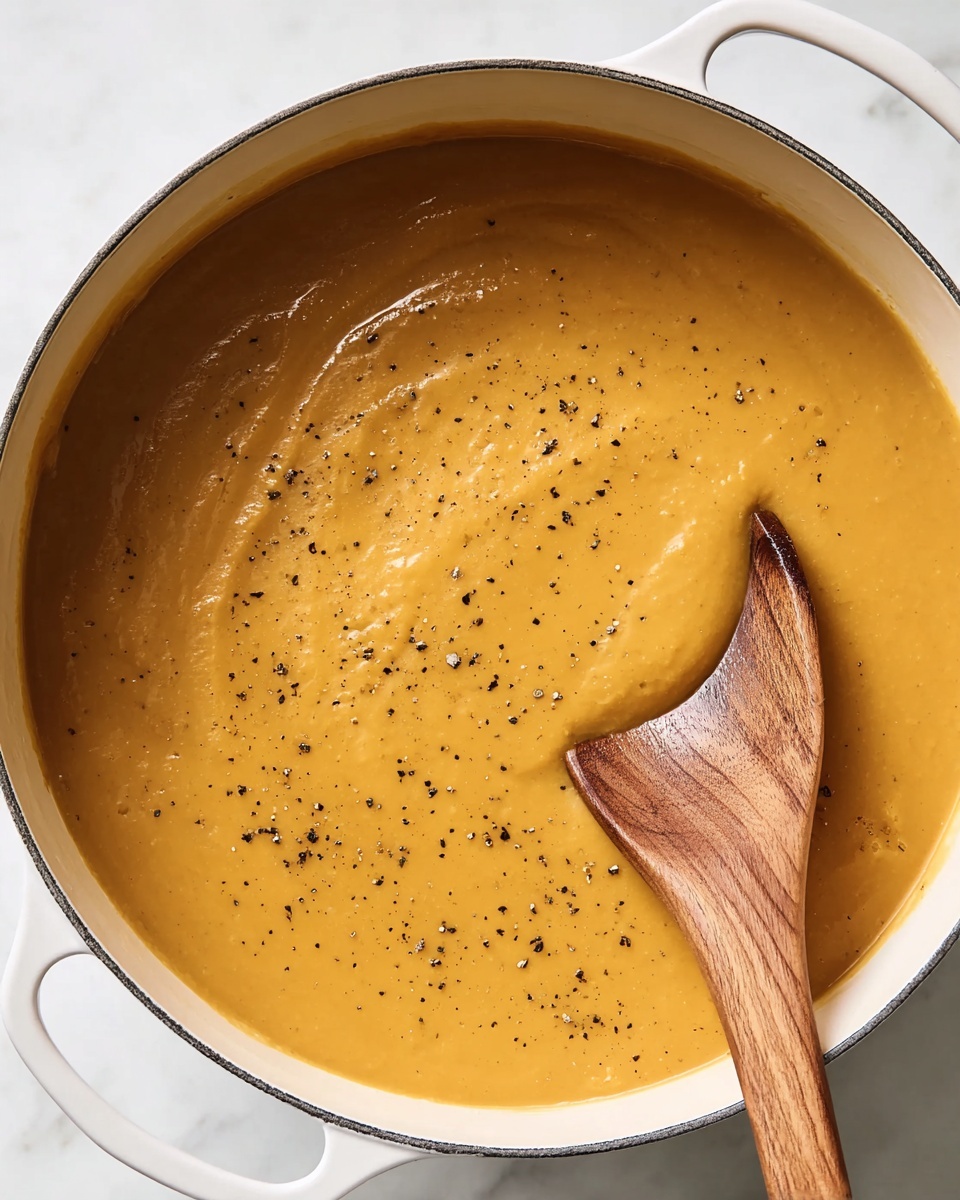
Ingredients & Why They Work
Each ingredient plays an important role in balancing flavors and textures. Plus, choosing fresh herbs and quality broth makes a noticeable difference, so keep an eye out for those when shopping.
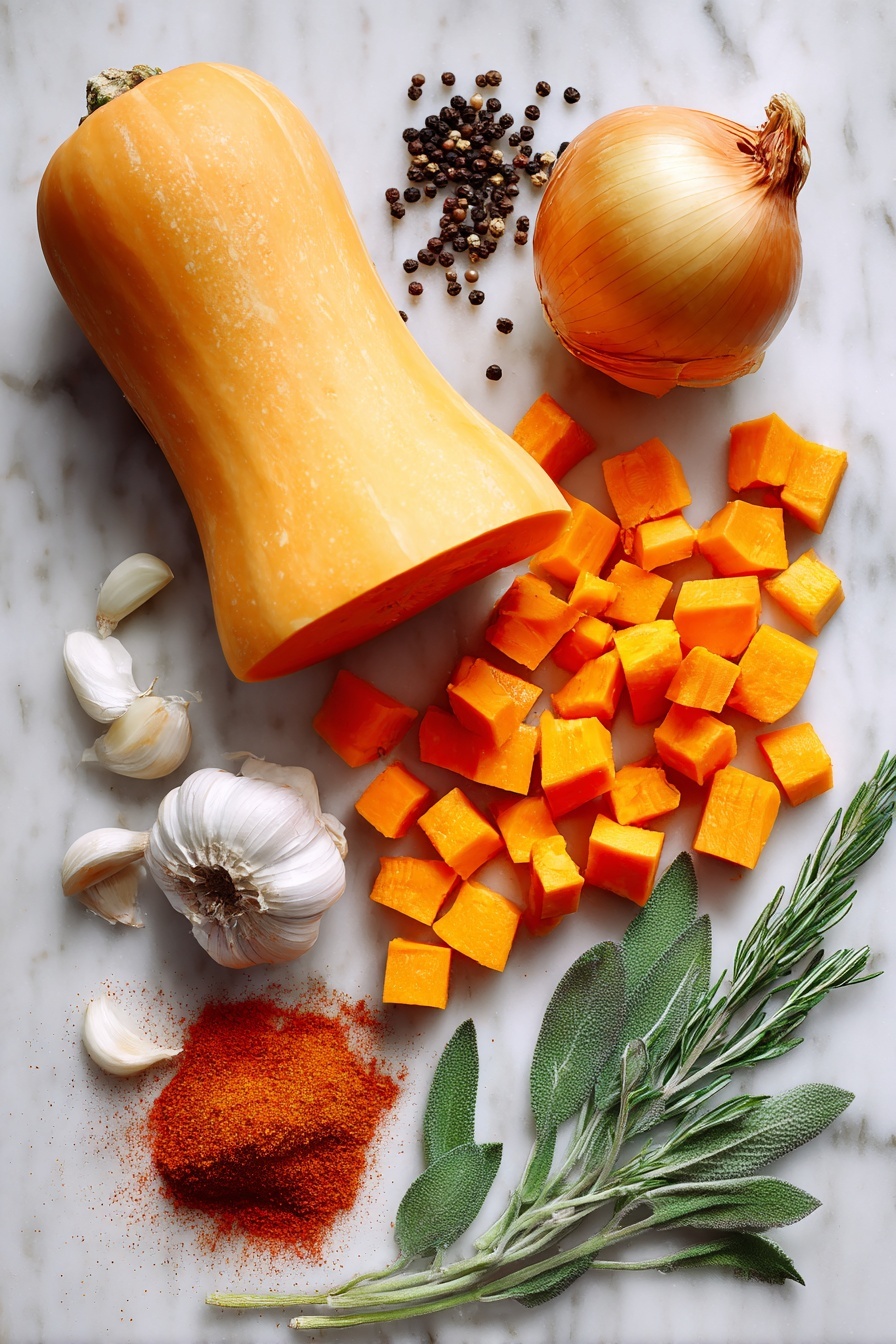
- Unsalted Butter or Olive Oil: Provides a flavorful base to sauté the vegetables gently and develop richness.
- Yellow Onion: Adds natural sweetness and depth as it softens and caramelizes.
- Carrots: Bring subtle earthy sweetness and body to the soup.
- Garlic: A mild but aromatic note that enhances savory complexity.
- Butternut Squash: The star! Its creamy flesh purees smoothly and offers natural sweetness.
- Vegetable or Chicken Broth: The liquid that ties everything together, use low sodium so you control salt levels.
- Fresh Sage, Thyme, or Rosemary: Bright herbal notes that elevate the soup without overpowering.
- Smoked Paprika: Adds warmth and a smoky hint that's my favorite unexpected twist.
- Kosher Salt and Black Pepper: Essential for seasoning and balancing flavors.
- Heavy Cream, Crème Fraîche, or Coconut Cream (Optional): For a silky finish if you want to indulge a little.
Make It Your Way
One of my favorite things about this butternut squash soup recipe is how easy it is to tweak and make your own. Whether you want it vegan, a little spicier, or richer — there’s room for creativity here.
- Vegan Variation: Swap the butter for olive oil and use coconut cream for drizzling instead of dairy — it’s delicious and creamy!
- Spice it Up: Add a pinch of cayenne pepper or a dash of chili flakes for a warm kick that lingers.
- Herb Swap: Try rosemary instead of sage for a piney aroma that transforms the flavor profile.
- Make it Heartier: Stir in cooked lentils or a spoonful of miso for extra depth and nutrition.
Step-by-Step: How I Make Butternut Squash Soup Recipe
Step 1: Sauté the Aromatics
I start by melting butter (or heating olive oil) in a heavy pot over medium-high heat. When it's hot, I add diced yellow onion, carrots, and garlic. Stirring often, I cook them until they’re softened and lightly golden—around 8 minutes. This is the flavor foundation, so don’t rush this step. If your onions start browning too fast, lower the heat a bit.
Step 2: Add Squash and Broth
Next, toss in your cubed butternut squash along with the broth, fresh chopped herbs, smoked paprika, and salt. Bring everything to a lively boil. The broth will help the squash cook down and soften.
Step 3: Simmer Until Tender
Once boiling, reduce the heat to a gentle simmer, partially cover the pot, and let it cook for 20 to 30 minutes. You’ll know it’s ready when the squash is fork-tender and starting to break apart. It’s the perfect stage for blending.
Step 4: Blend Until Smooth
Turn off the heat and carefully blend the soup until silky smooth. I like using an immersion blender right in the pot — easy and less mess. But if you use a regular blender, just do it in batches and be careful with the hot liquid. Taste and adjust salt and pepper.
Step 5: Serve with a Drizzle
Finish with a swirl of heavy cream, crème fraîche, or coconut cream for extra richness if you want. Sprinkle some fresh herbs and cracked black pepper on top for a beautiful touch.
Top Tip
Through several batches, I’ve realized the magic lies in layering flavors and being patient with the aromatics. Skipping the slow sauté step results in a flatter soup — so don’t rush it!
- Slow Sauté on Onions: Take your time until they’re translucent and golden; this builds a naturally sweet base.
- Use Fresh Herbs: I always use fresh sage or thyme instead of dried — it brightens the whole soup.
- Blend in Batches if Needed: Overfilling your blender risks hot soup spills—careful safety first!
- Adjust with Salt at the End: It’s better to under-salt when cooking and add more after blending because flavors concentrate.
How to Serve Butternut Squash Soup Recipe
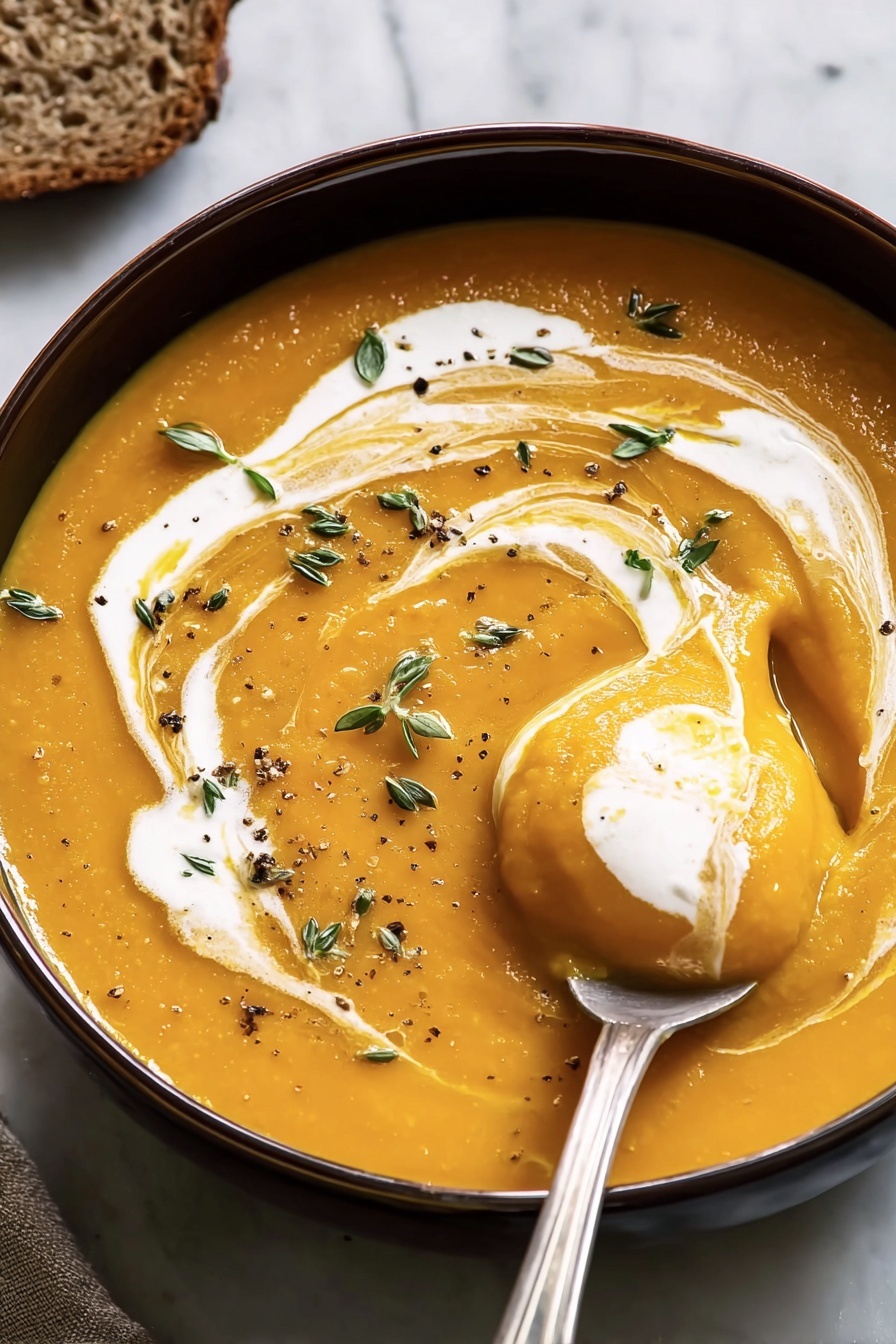
Garnishes
I’m a big fan of fresh sage leaves on top for that herbal zing. Sometimes I sprinkle toasted pumpkin seeds for crunch, or add a tiny drizzle of chili oil to turn up the heat. A swirl of cream or coconut cream not only looks pretty but adds an inviting richness.
Side Dishes
This soup pairs beautifully with crusty bread—especially a warm sourdough loaf—and a simple green salad for a well-rounded meal. If you're feeling indulgent, a grilled cheese sandwich is the ultimate partner here.
Creative Ways to Present
For a cozy dinner party, I like serving the soup in mini pumpkins hollowed out and roasted — such a beautiful statement! Or ladle it into ramekins topped with herb crème fraîche and a sprinkle of smoked paprika for a colorful touch.
Make Ahead and Storage
Storing Leftovers
Once cooled, I store leftover soup in airtight containers in the fridge for up to 4 days. The flavors deepen and meld wonderfully overnight — I actually prefer it the next day!
Freezing
This soup freezes like a charm. I portion it into freezer-safe containers or bags, leaving some room for expansion, and it lasts up to 3 months. When thawed, the texture stays nice and creamy after reheating.
Reheating
To reheat, I gently warm it over low heat on the stove, stirring occasionally. If it’s too thick, I add a little broth or water to loosen it up. Microwave works fine too, just stir halfway through to keep it creamy.
Frequently Asked Questions:
Absolutely! Frozen butternut squash is a great shortcut that works well in this recipe. Just adjust cooking time slightly since frozen squash tends to cook faster — keep an eye on it and simmer until tender.
If fresh sage, thyme, or rosemary aren’t available, you can substitute with about 1 teaspoon of dried herbs, added early in the cooking process so the flavors can bloom. Fresh always tastes brighter, but dried herbs do the job in a pinch.
Yes! You can add a pinch of cayenne pepper, red chili flakes, or even a diced jalapeño during the sauté step. I recommend adding a little at a time and tasting as you go to find the perfect heat level for you.
Definitely. In fact, this soup tastes even better the day after because the flavors meld so nicely. Prepare it the day before, refrigerate, and reheat gently before serving at your gathering. Just add your garnishes fresh for that pop of color and flavor.
Final Thoughts
Making this butternut squash soup recipe always feels like a hug in a bowl to me, and I hope it gives you that same cozy feeling. It’s approachable, versatile, and really satisfying whether you’re new to cooking or a seasoned pro. Give it a try soon — I’d love to hear how you make it your own!
Print
Butternut Squash Soup Recipe
- Prep Time: 15 minutes
- Cook Time: 30 minutes
- Total Time: 45 minutes
- Yield: 6 servings
- Category: Soup
- Method: Stovetop
- Cuisine: American
- Diet: Vegetarian
Description
A creamy and comforting Butternut Squash Soup made with sautéed vegetables, fresh herbs, and smooth pureed squash, perfect for a cozy meal or appetizer.
Ingredients
Main Ingredients
- 3 tablespoons unsalted butter or olive oil
- 1 large yellow onion, diced (about 1 ¾ cups)
- 2 medium carrots, peeled and diced (about 1 cup)
- 4 cloves garlic, crushed and peeled
- 1 large (about 3-pound) butternut squash, peeled, seeded, and cut into 1-inch chunks (about 8 cups)
- 1 (32-ounce) carton low-sodium vegetable or chicken broth (4 cups)
- 2 teaspoons finely chopped fresh sage, thyme, or rosemary leaves (from about 2 sprigs), plus more for garnish
- ½ teaspoon smoked paprika
- ½ teaspoon kosher salt, plus more as needed
- Freshly ground black pepper
- Heavy cream, crème fraîche, or coconut cream, for drizzling (optional)
Instructions
- Sauté vegetables: Melt 3 tablespoons unsalted butter in a medium Dutch oven or heavy-bottomed pot over medium-high heat. Add the diced onion, peeled and diced carrots, and crushed garlic cloves. Cook, stirring occasionally, until the vegetables are softened and lightly browned in spots, about 8 minutes.
- Add squash and broth: Stir in the chopped butternut squash, low-sodium vegetable broth, finely chopped fresh sage leaves, smoked paprika, and kosher salt. Bring the mixture to a boil.
- Simmer the soup: Reduce the heat to maintain a simmer. Partially cover the pot and cook until the squash is tender and starting to fall apart, about 30 minutes.
- Puree the soup: Turn off the heat. Use an immersion blender to puree the soup directly in the pot until creamy and smooth. Alternatively, blend in batches in a stand blender. Taste and season with additional kosher salt and freshly ground black pepper as needed.
- Serve: Ladle soup into bowls and drizzle with heavy cream, crème fraîche, or coconut cream if desired. Garnish with more finely chopped fresh sage leaves and freshly ground black pepper.
Notes
- Use olive oil instead of butter for a dairy-free version.
- For a vegan version, use vegetable broth and coconut cream instead of chicken broth and heavy cream.
- If you don't have fresh herbs, substitute with 1 teaspoon dried sage or thyme.
- The soup thickens as it cools; add more broth or water when reheating if needed.
- To speed up the peeling of butternut squash, microwave it for 2 minutes before peeling.
Nutrition
- Serving Size: 1 cup
- Calories: 180 kcal
- Sugar: 6 g
- Sodium: 350 mg
- Fat: 8 g
- Saturated Fat: 3 g
- Unsaturated Fat: 5 g
- Trans Fat: 0 g
- Carbohydrates: 25 g
- Fiber: 4 g
- Protein: 3 g
- Cholesterol: 15 mg

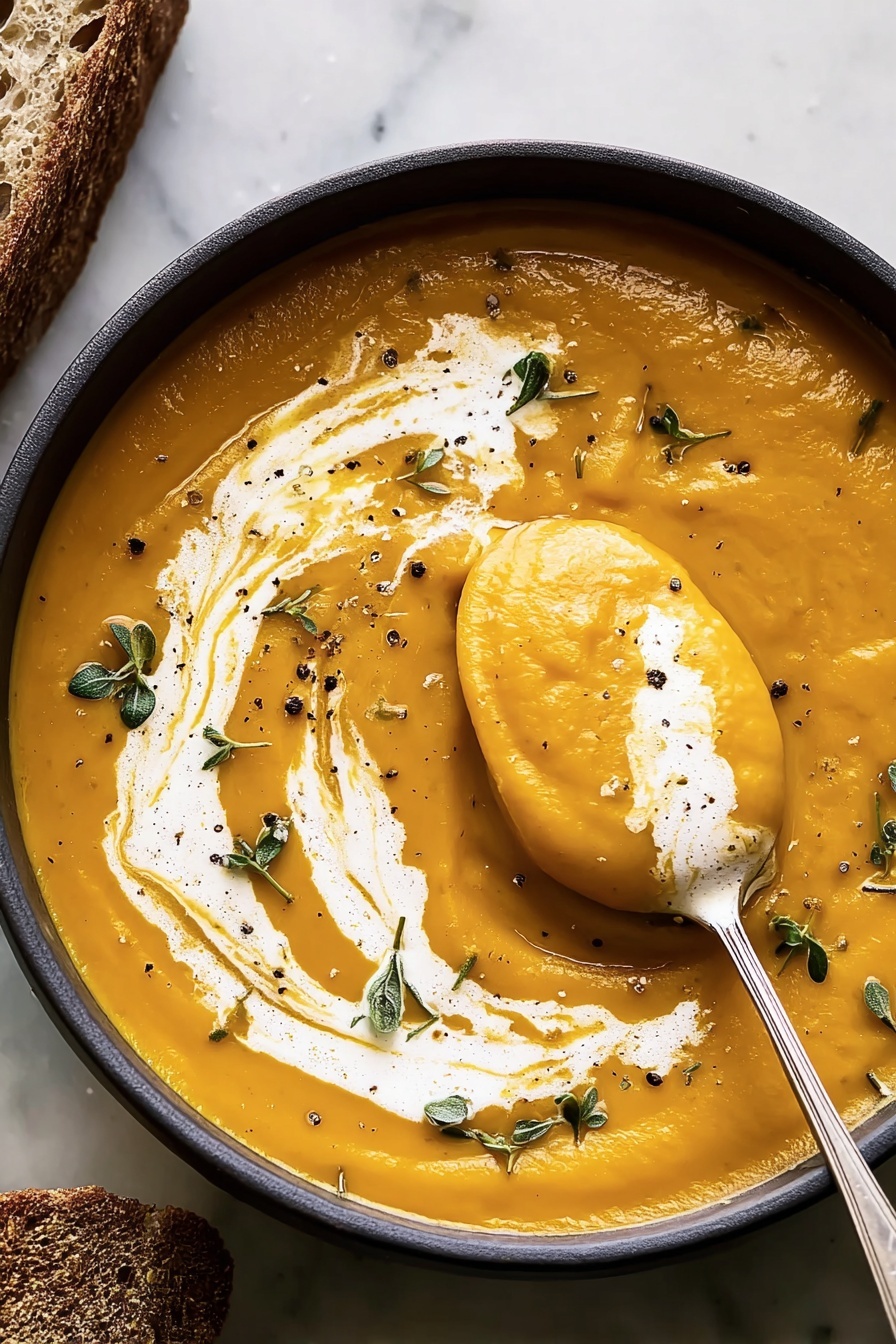


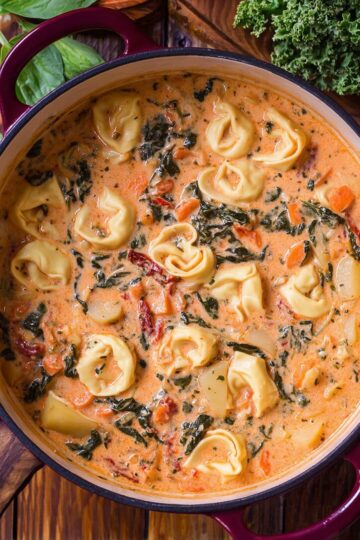
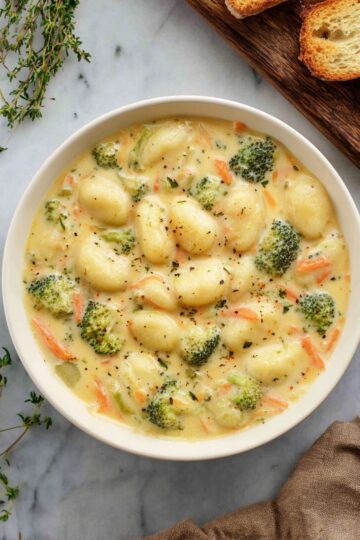

Leave a Reply